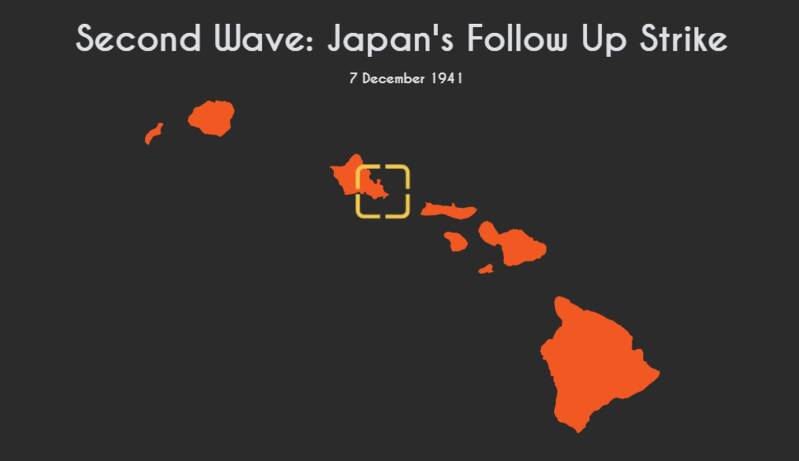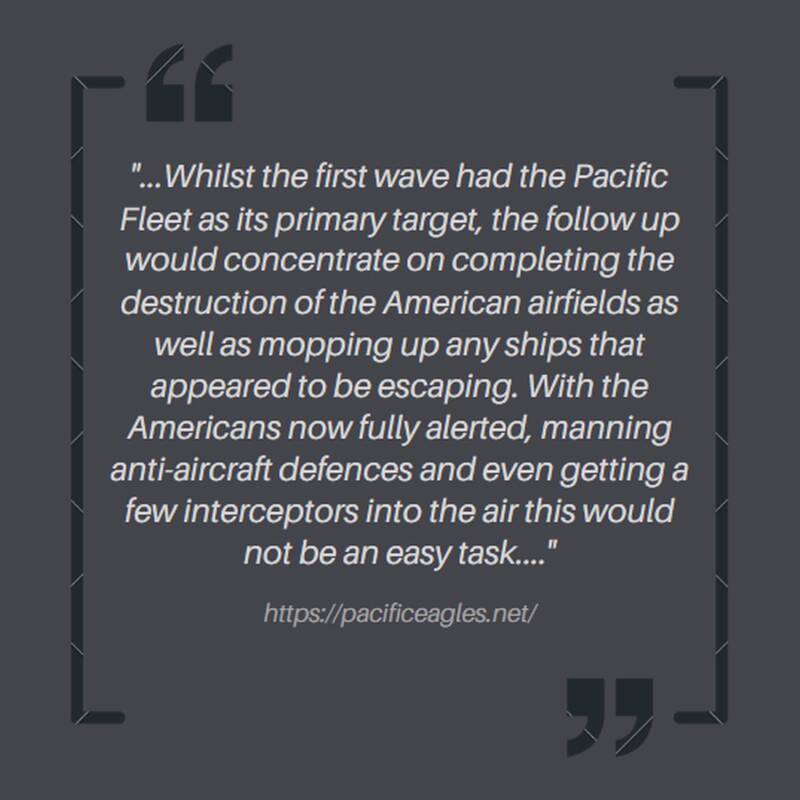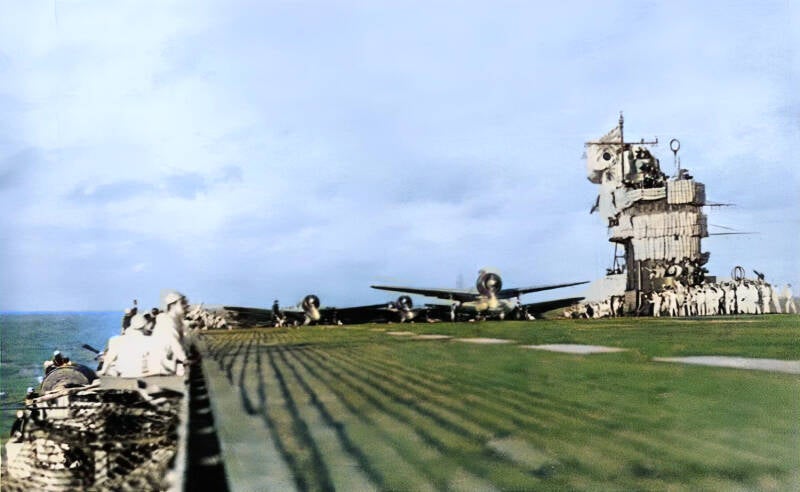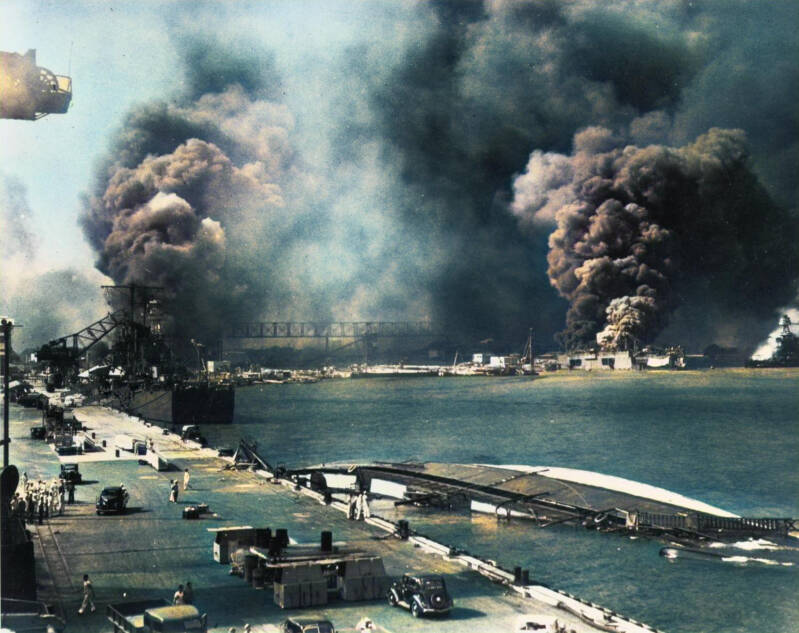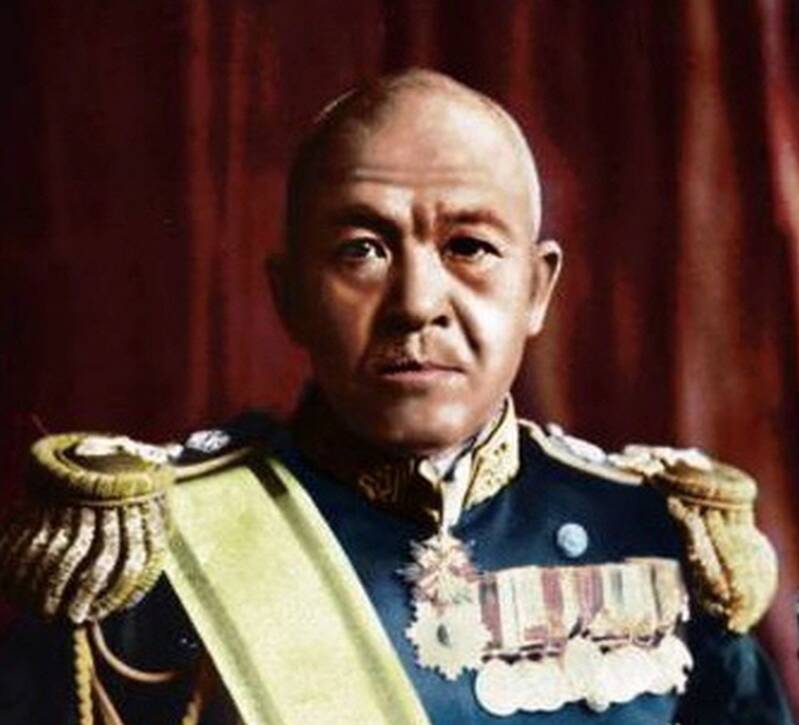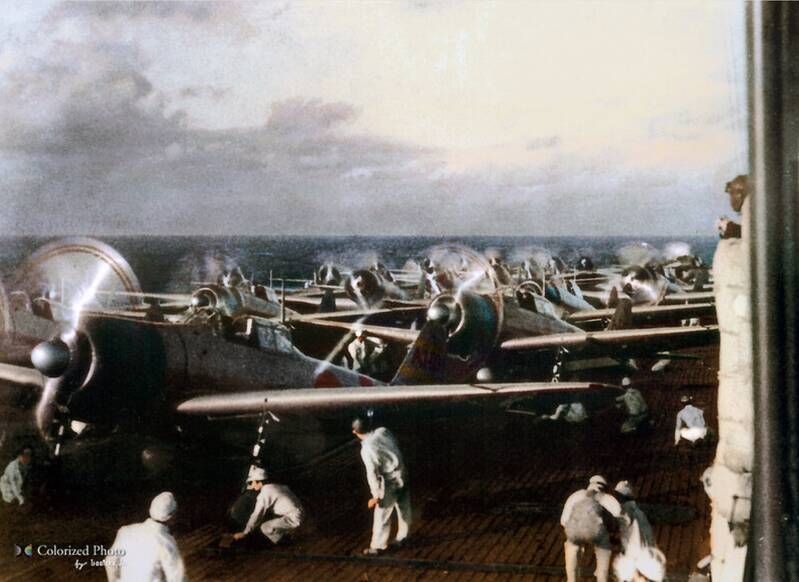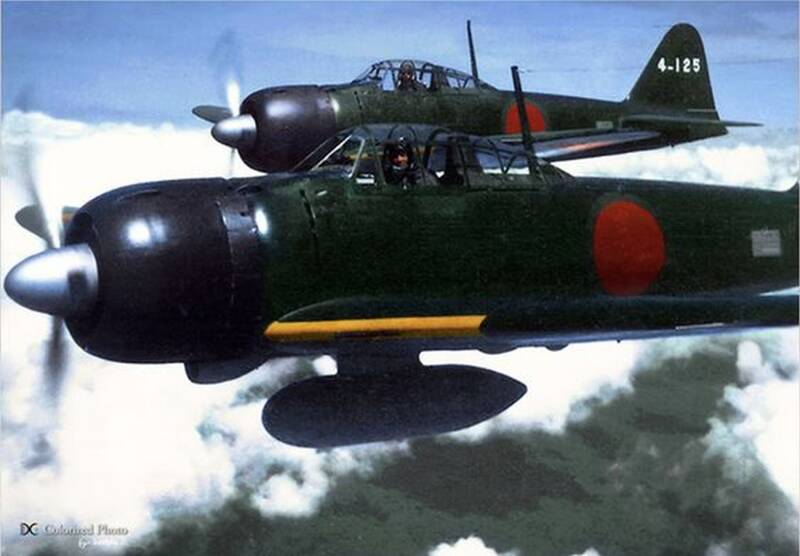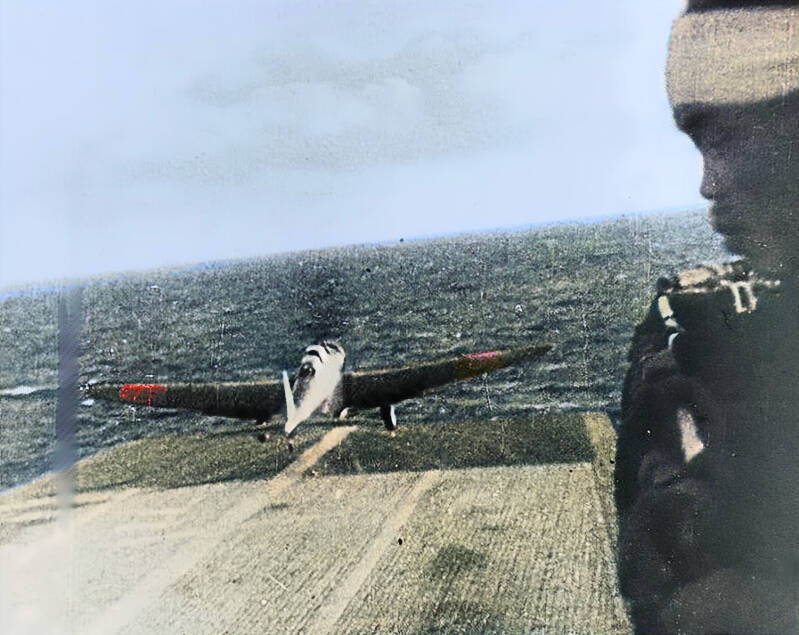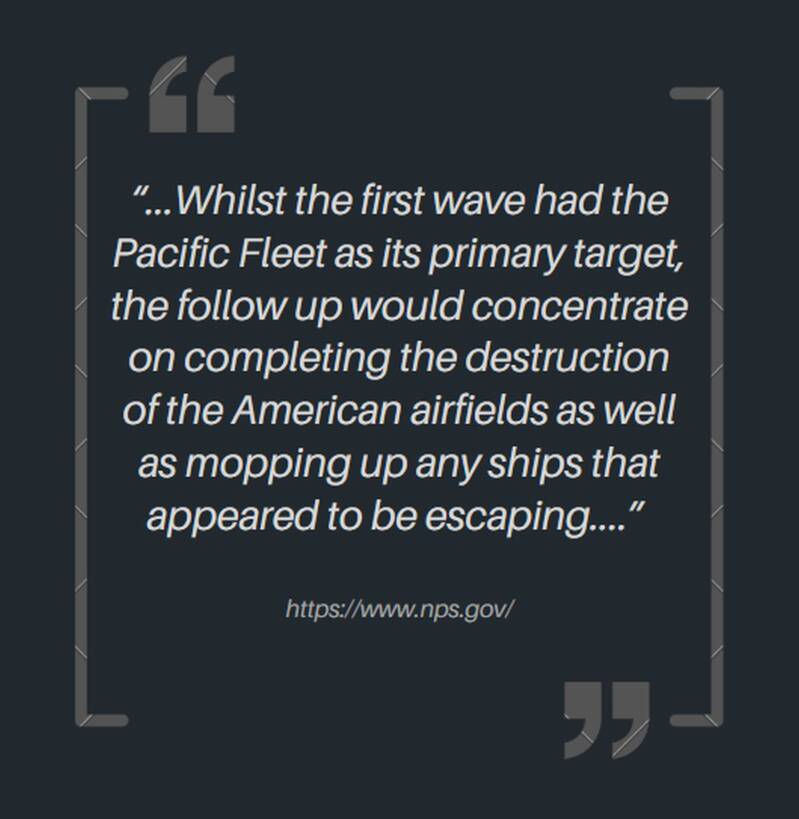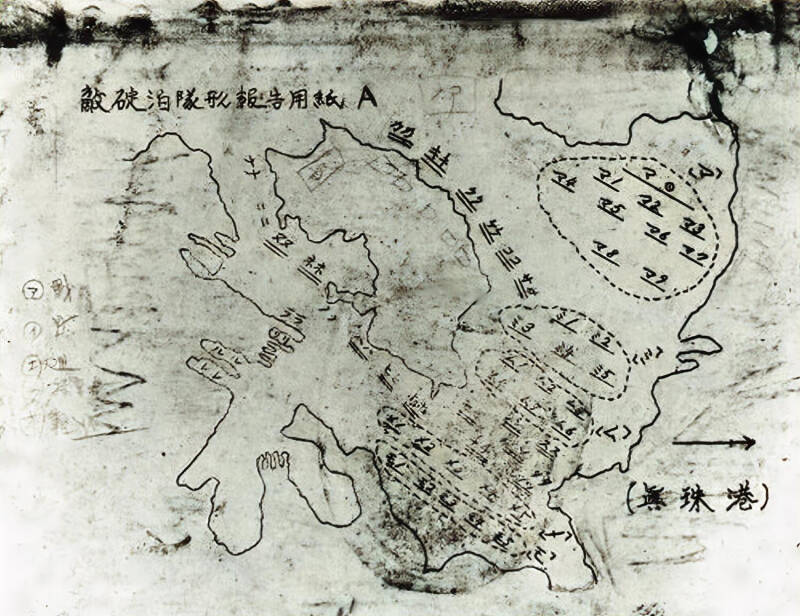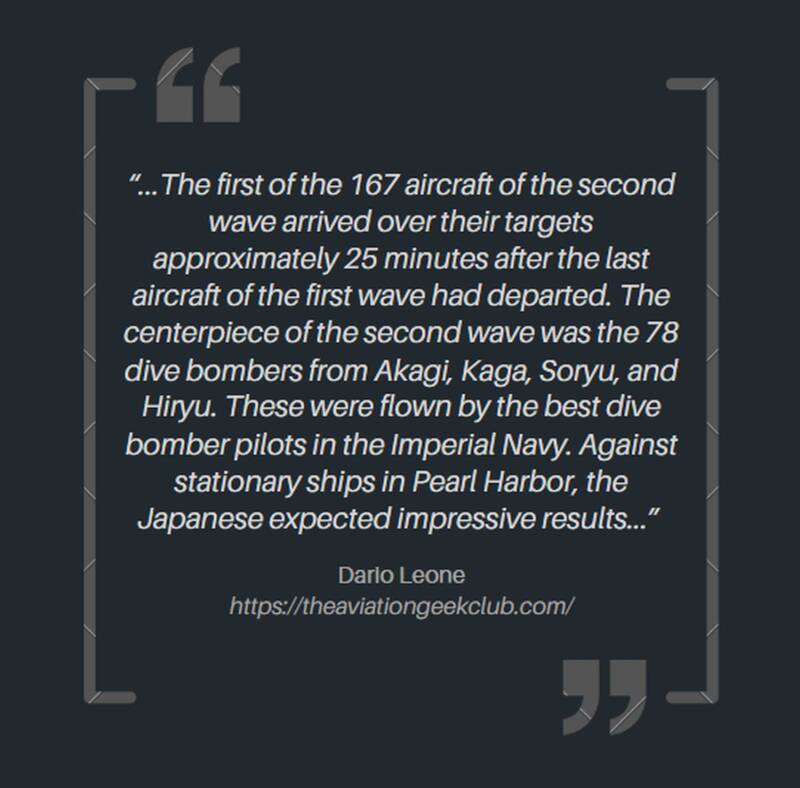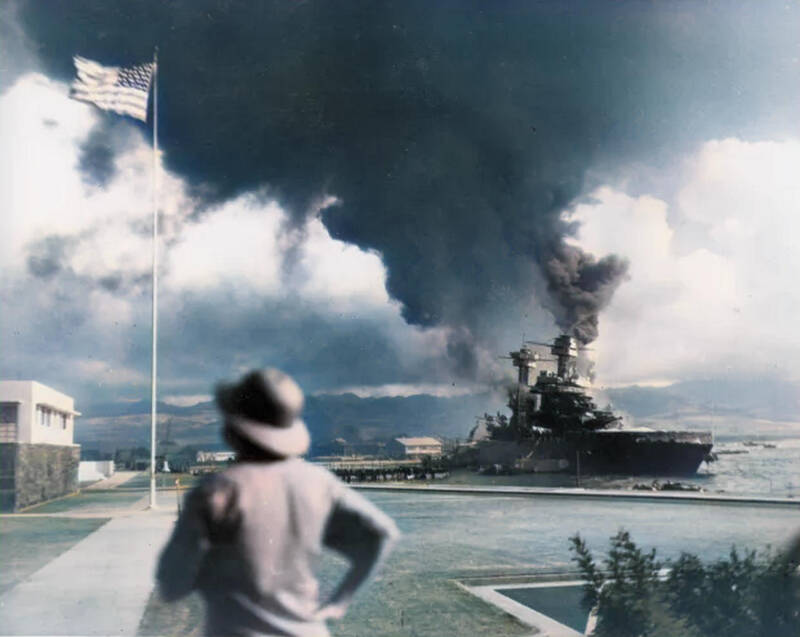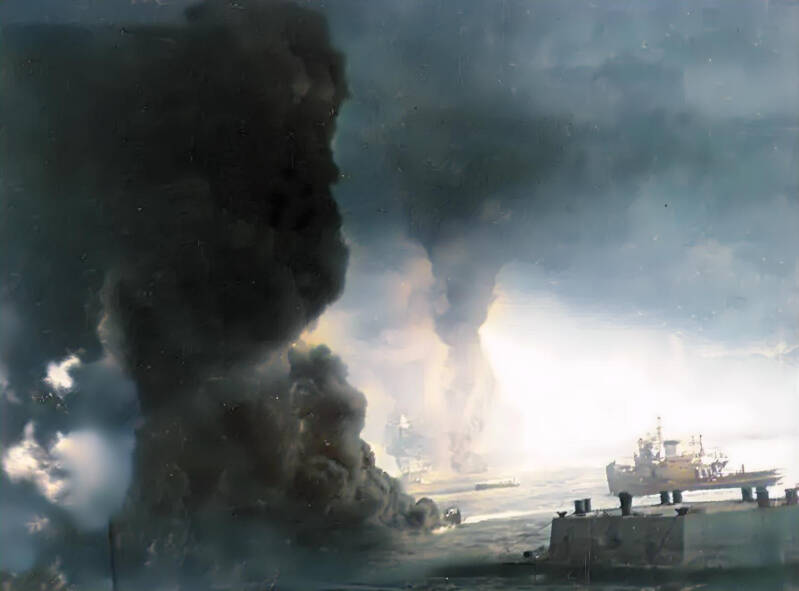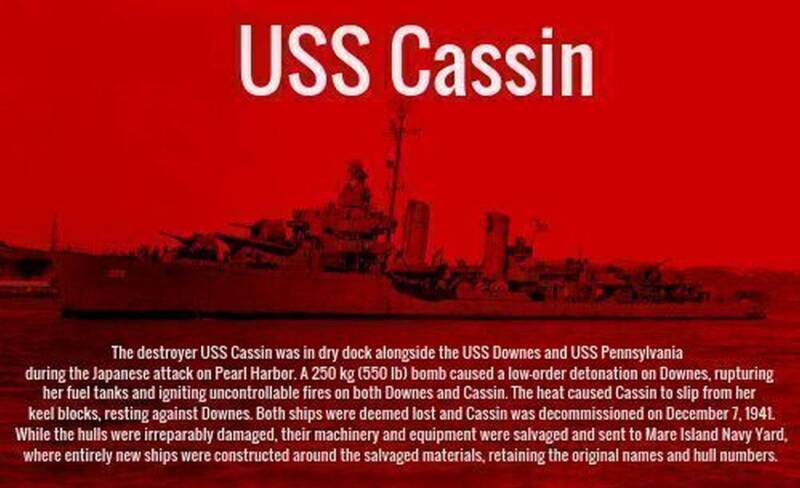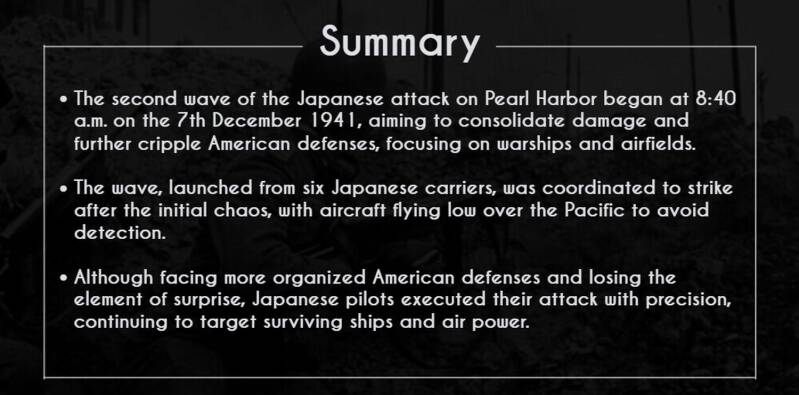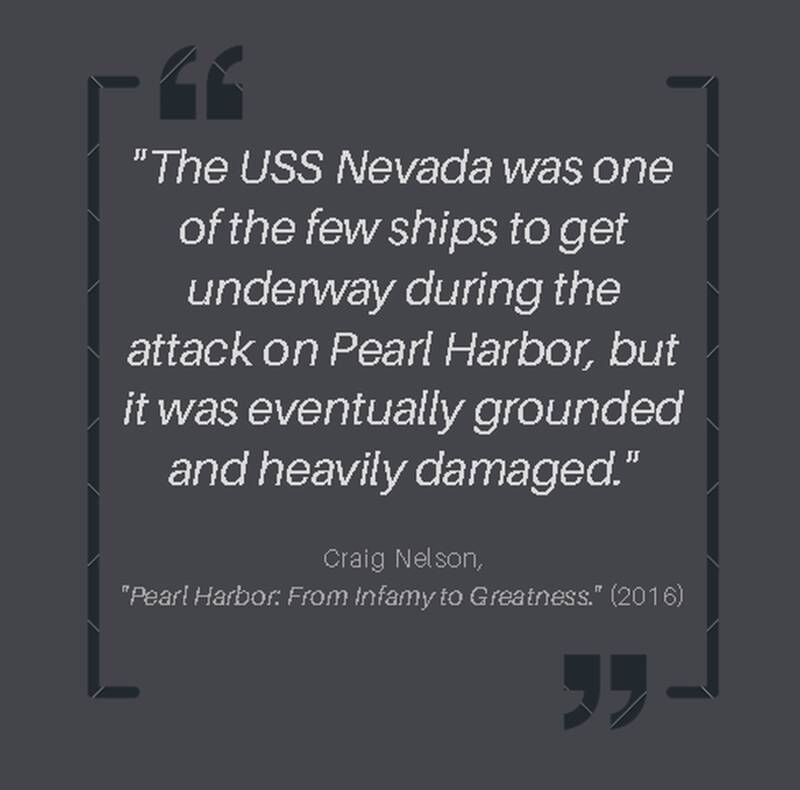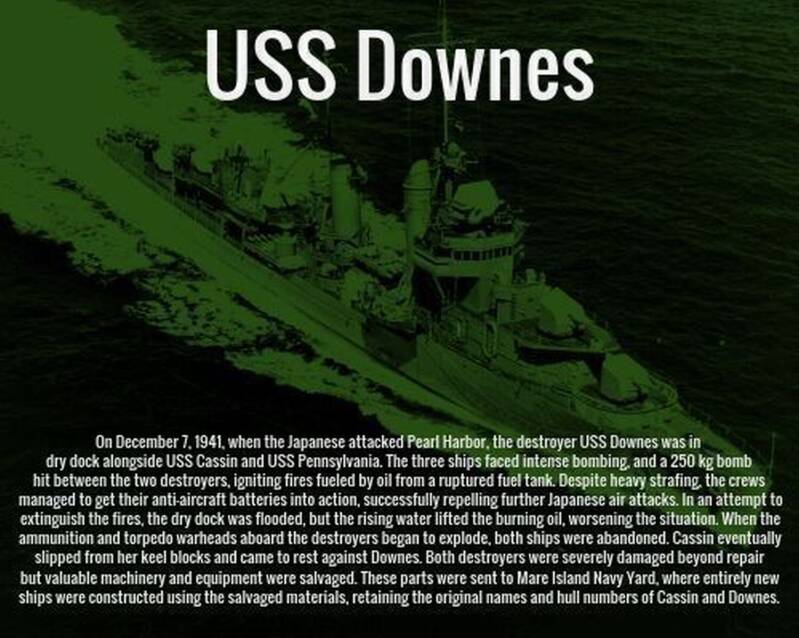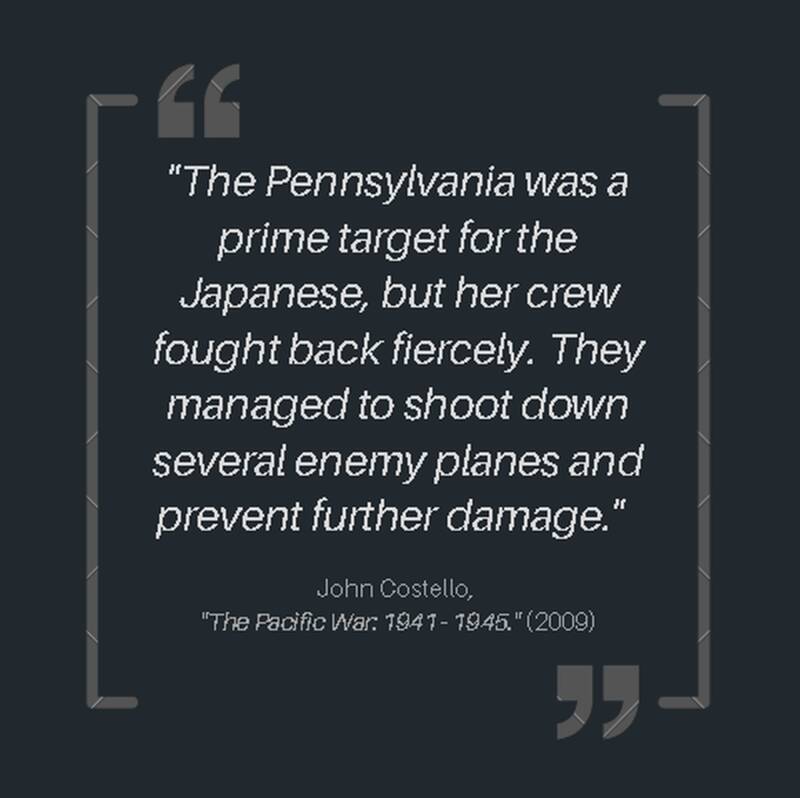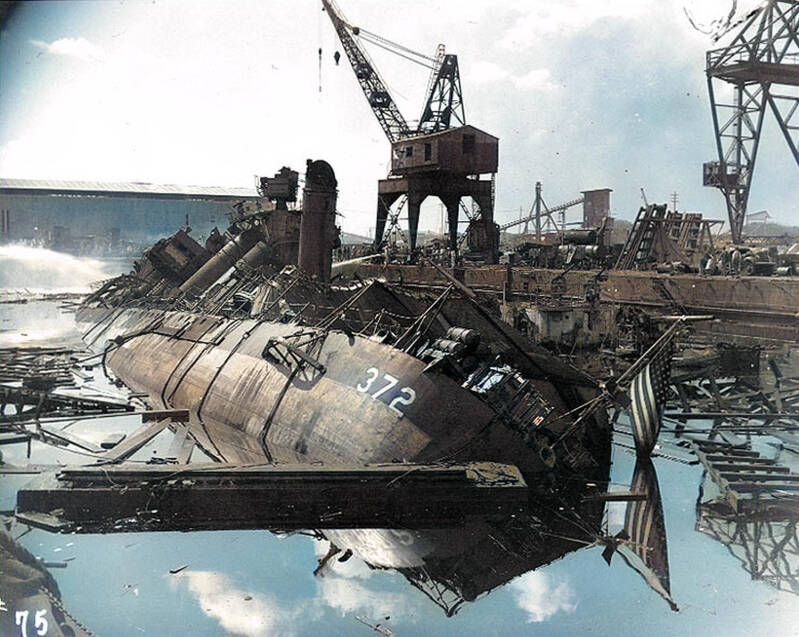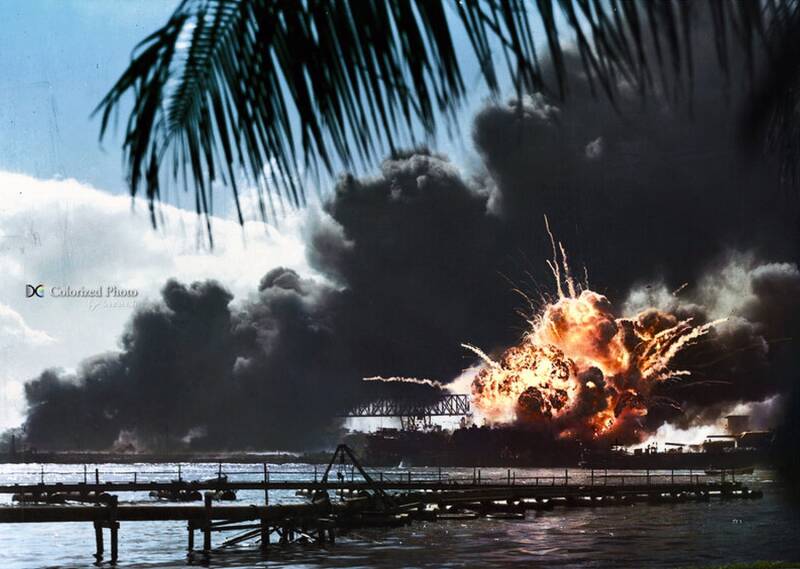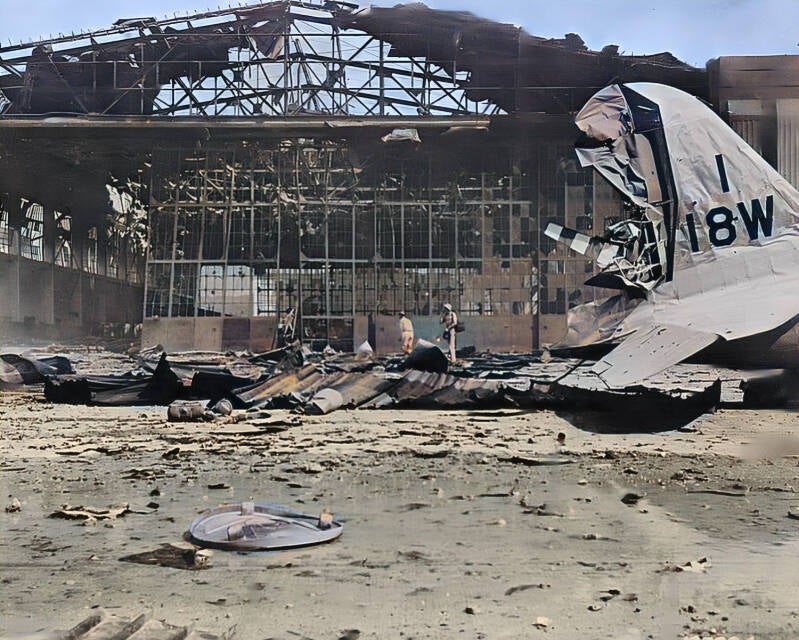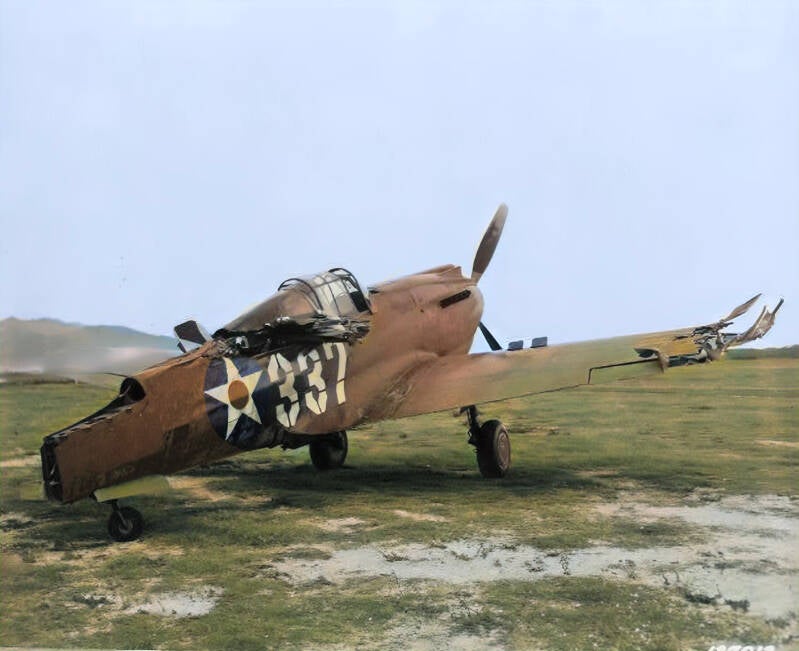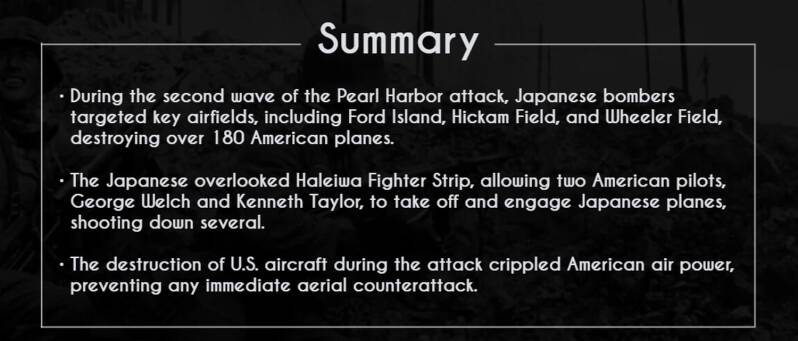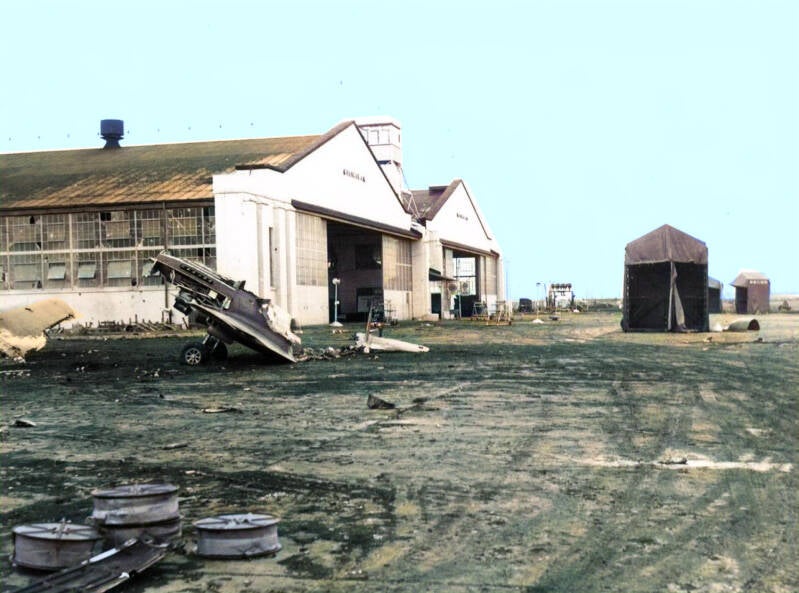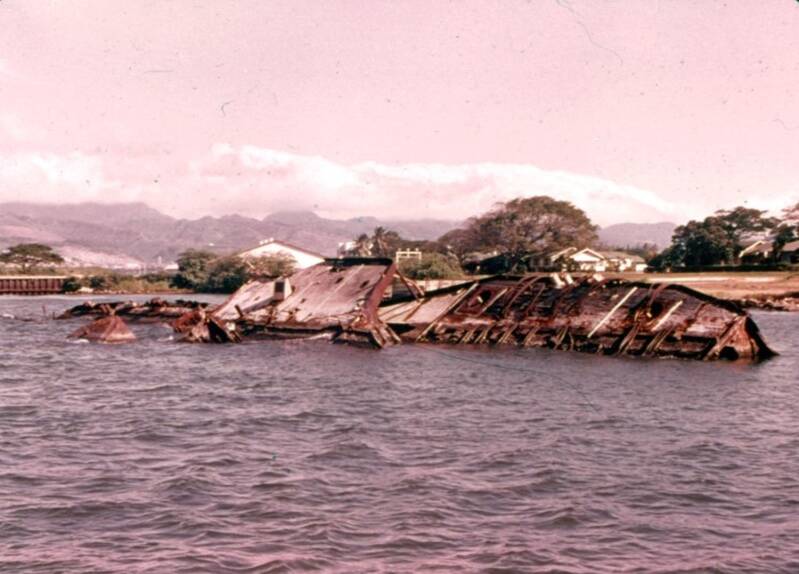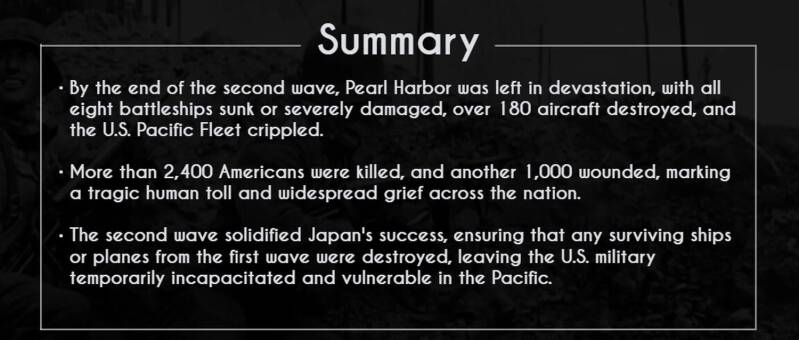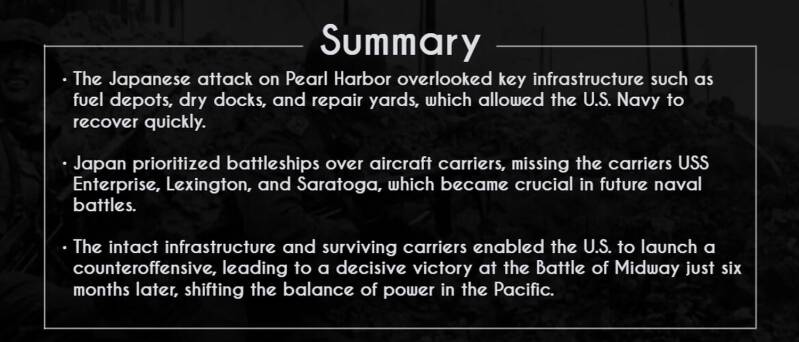Piling On The Torment
Revisiting Pearl Harbor: The Impact of the Second Wave
The second wave of the Japanese attack on Pearl Harbor, launched at approximately 8:40 a.m. on the 7th December 1941, was a critical phase in Japan’s effort to incapacitate the U.S. Pacific Fleet.
While the first wave had successfully taken the Americans by surprise, inflicting heavy damage on battleships and airfields, the second wave aimed to consolidate and complete the destruction.
The second wave of attack aircraft launches from the Imperial Japanese Navy aircraft carrier Akagi against Pearl Harbor.
Makiel Collection via Wenger
...the second wave delivered devastating blows...
Comprised of 170 aircraft, including bombers, dive-bombers, and Zero fighters, the second wave targeted ships that had survived the initial onslaught and sought to eliminate any remaining American air power.
Although U.S. defences had begun to organize, the second wave delivered devastating blows, particularly to vessels like the USS Nevada and airfields such as Ford Island.
This assault left Pearl Harbor in ruins, and while less shocking than the first, it ensured that the U.S. military would be crippled in the immediate aftermath, marking a turning point in the Second World War.
Devastation at Pearl harbor: Helena (center left) at 1010 dock after the attack; Oglala has been towed astern where she capsized. Smoke clouds from the burning destroyers Cassin and Downes rise in the distance beyond Helena, while those from the battleship Nevada are visible to the right. The battleship California is down by the bow but has not yet sunk.
The Japanese Second Wave
The second wave of the Japanese attack on Pearl Harbor was meticulously organized into three distinct groups.
Like the first wave, these planes were launched from the same six aircraft carriers—Akagi, Kaga, Soryu, Hiryu, Shokaku, and Zuikaku—stationed to the north of Hawaii, under the overall command of Vice Admiral Chuichi Nagumo.
First Group – Dive Bombers: This group included 78 Aichi D3A "Val" dive-bombers, which were assigned to target any surviving American warships, particularly focusing on battleships and vessels still afloat.
The USS Nevada was a key target due to its attempt to escape the harbor. These dive-bombers were crucial in delivering precision strikes to finish off damaged ships.
Vice Admiral Chuichi Nagumo. Nagumo, commanding the Japanese strike force at Pearl Harbor, oversaw the second wave, which reinforced the initial attack but encountered stronger American resistance.
The second wave of strike aircraft prepare to launch of the Akagi.
...to destroy any remaining planes...
Second Group – High-Level Bombers: The second group, consisting of 54 Nakajima B5N "Kate" high-level bombers, was tasked with targeting American airfields that had already been hit during the first wave.
Their mission was to destroy any remaining planes and further incapacitate key airfields like Hickam, Ford Island, and Wheeler Field, ensuring that the U.S. military's air capabilities were neutralized.
A Japanese plane, braving American anti-aircraft fire, proceeds toward Battleship Row, Pearl Harbor, after other bombers had hit USS. Arizona, from which smoke billows. During the second wave of the Pearl Harbor attack, Japanese aircraft focused on targeting warships and airfields. Dive-bombers attacked surviving ships, while bombers aimed to destroy remaining planes and infrastructure, facing more organized American resistance but still inflicting significant damage.
AP Photo
https://www.mercurynews.com/2017/12/07/historical-photos-of-pearl-harbor-attack-on-december-7-1941/
...these fighters strafed airfields...
Third Group – Fighter Escorts: The third group was composed of 36 Mitsubishi A6M Zero fighters, which served a dual purpose.
They provided air cover for the bombers, protecting them from any remaining American aircraft that might have taken to the skies.
Additionally, these fighters strafed airfields and ground targets, adding to the chaos on the ground and preventing any organized defense.
A B5N torpedo bomber launching from the Shokaku.
...especially targeting the USS Nevada...
The tactical objectives of the second wave were clear: to neutralize any remaining ships and aircraft that had survived the initial attack.
Japanese bombers focused their attention on crippling the U.S. Pacific Fleet’s battleships, especially targeting the USS Nevada, which was attempting to escape the harbor.
The second wave also aimed to destroy remaining American aircraft on the ground, focusing on key airfields such as Hickam Field, Wheeler Field, and Ford Island.
Recovered from a Japanese Navy aircraft downed during the attack on Pearl Harbor, 7 December 1941. The chart identifies ship mooring locations and is entitled (at upper left): Report on positions of enemy fleet at anchorage A. Code at left represents ship types (Letter figures are written in katakana): A - battleship; I - aircraft carrier; E - cruiser; U - special service ship; O - light cruiser. Mooring locations are coded with paired katakana figures or with katakana plus an arabic numeral, but do not specifically identify the ship types moored there.
Official U.S. Navy Photograph, now in the collections of the National Archives
https://pacificeagles.net/gallery-pearl-harbor-december-7th-1941/
...succeeded in reinforcing the devastation...
Strategically, the Japanese sought to ensure that the U.S. military would be unable to launch an immediate counterattack, either by air or sea, thus consolidating Japan’s dominance in the Pacific.
By striking both naval and air assets, Japanese planners hoped to extend the operational success of the first wave and prevent American forces from retaliating in the short term.
Despite facing a more organized defence, the second wave succeeded in reinforcing the devastation, ensuring that Pearl Harbor would be left incapacitated in the immediate aftermath.
The Commanding Officer of the Japanese aircraft carrier Shokaku watches as planes take off to attack Pearl Harbor, during the morning of 7 December 1941. The Kanji inscription at left is an exhortation to pilots to do their duty.
Official U.S. Navy Photograph, now in the collections of the National Archives.
https://pacificeagles.net/gallery-pearl-harbor-december-7th-1941/
The Second Wave Strikes
The second wave of the Japanese attack on Pearl Harbor, which began at approximately 8:40 a.m. on the 7th December 1941, was designed to consolidate the damage inflicted by the initial assault and to further cripple American defences.
The force was led by Lieutenant Commander Egusa Takeshige from Soryu who was considered to be the finest dive bomber pilot in the Imperial Navy.
Although the first wave had caught the U.S. forces off guard, wreaking havoc on battleships and airfields, the second wave faced a slightly more organized defence, as some American personnel had scrambled to respond.
Despite this, the second wave still delivered a devastating blow, focusing on finishing off warships and airfields that had escaped the first wave relatively unscathed.
American ships burn during the Japanese attack on Pearl Harbor.
AP Photos
https://www.mercurynews.com/2017/12/07/historical-photos-of-pearl-harbor-attack-on-december-7-1941/
...the distant sounds of explosions...
Lieutenant Commander Egusa Takeshige led the Japanese second wave.
https://forummarine.forumactif.com/t9407-biographie-takashige-egusa
The second wave – consisting of bombers, dive-bombers, and Zero fighters - launched from the six Japanese aircraft carriers stationed to the north of Hawaii.
Their approach was carefully coordinated to strike just as the initial chaos from the first wave began to subside.
Navigating through cloud cover, they flew low over the Pacific Ocean, following well-rehearsed routes to avoid early detection.
As they neared Pearl Harbor, the distant sounds of explosions and rising plumes of smoke confirmed the success of the first wave
The aircraft were focussed on their mission: target any remaining ships that had survived the initial onslaught and ensure that American air power was further crippled.
By this time, the element of surprise had been lost, and American anti-aircraft fire was more organized.
Nonetheless, the Japanese pilots pressed their attack with precision.
Heavy black smoke billows as oil fuel burns from shattered tanks on ships that were hit during the Japanese attack on Pearl Harbor, Hawaii on the 7th December 1941 during the Second World War. Visible through the murk is the U.S. battleship Maryland, center, and the hulk of the capsized USS Oklahoma to the right of it.
AP Photo/U.S. Navy
...after-action reports were often inaccurate or misleading...
With no aircraft carriers present and the 550lb bombs carried by Japanese dive bombers unsuitable for penetrating the heavily armored battleships, the attack plan prioritized cruisers as the primary targets.
However, in practice, only 17 dive bombers targeted cruisers, while around 30 attacked battleships, 16 focused on destroyers, and 12 struck auxiliary ships.
Japanese after-action reports were often inaccurate or misleading, and even when cross-referenced with American reports, it remains challenging to account for the actions of all 78 dive bombers.
What is clear, however, is that the dive bomber attack lacked focus and did not meet Japanese expectations.

Targeting the USS Nevada
One of the primary targets of the second wave was the USS Nevada. This battleship had been hit during the first wave but had managed to get underway in an attempt to escape the harbor.
As the only battleship in motion during the attack, the Nevada became a prime target for the second wave of Japanese dive-bombers.
The crew of the Nevada found themselves in a frantic race against time as the second wave of Japanese bombers descended.
After being hit during the first wave, the battleship had miraculously managed to get underway, and the mood aboard was tense yet hopeful.
Amidst the chaos, her crew worked feverishly to steer the damaged ship out of the harbour in an attempt to escape further destruction.
USS Nevada (BB-36) beached and burning after being hit forward by Japanese bombs and torpedoes. Her pilothouse area is discolored by fires in that vicinity. The harbor tug Hoga (YT-146) is alongside Nevada's port bow, helping to fight fires on the battleship's forecastle.
Official U.S. Navy Photograph, now in the collections of the U.S. National Archives
https://www.ibiblio.org/hyperwar/OnlineLibrary/photos/events/wwii-pac/pearlhbr/ph-nv2.htm
...multiple direct hits caused severe damage...
As the only battleship in motion, the Nevada became a prime target for Japanese dive-bombers, who recognized the significance of her potential breakout. Bombs rained down as the ship fought through thick smoke and relentless attacks.
Despite her valiant effort, multiple direct hits caused severe damage, and it became clear that escaping the harbor was no longer possible.
In a desperate attempt to avoid sinking and blocking the vital channel, the crew made the gut-wrenching decision to beach the Nevada on the shores of Hospital Point.
Her bold escape attempt had come close, but in the end, she was forced to submit to the overwhelming assault.
The Nevada would later be refloated and repaired, but the damage inflicted during the second wave was severe.
Helena (center left) - a Brooklyn-class light cruiser - at 1010 dock after the attack; the minelayer Oglala has been towed astern where she capsized. Smoke clouds from the burning destroyers Cassin and Downes rise in the distance beyond Helena, while those from the battleship Nevada are visible to the right. The battleship California is down by the bow but has not yet sunk.
...causing explosions and igniting fires that spread across the dry dock...
Other battleships also took hits in the second wave.
The USS Pennsylvania, positioned in dry dock, suffered significant damage when it was hit by Japanese bombs.
One bomb struck near the stern, causing explosions and igniting fires that spread across the dry dock.
Though the Pennsylvania was not as heavily damaged as other battleships, the attack caused casualties aboard and left the ship requiring repairs, which were completed soon after.
USS Pennsylvania (BB-38) was the lead ship of the Pennsylvania-class of battleships built for the US Navy in the 1910's. The Pennsylvania suffered slight damage during the Second Wave attack, but it comparison to some of the other US battleships, escaped relatively unscathed.
...suffered catastrophic damage...
During the second wave of the Pearl Harbor attack, several U.S. ships, aside from battleships, suffered significant damage.
The destroyers USS Cassin and USS Downes, both in dry dock, were struck by bombs, causing devastating fires and extensive damage to both ships, with the dry dock itself became a chaotic scene as personnel struggled to contain the fires.
The Cassin was so badly damaged that it listed over and came to a rest with its superstructure leaning against the Downes.
USS Cassin (DD-372) burned out and capsized against USS Downes (DD-375), in the Pearl Harbor Navy Yard drydock on the 7th December 1941, after the Japanese attack.
Official U.S. Navy Photograph, now in the collections of the National Archives.
https://www.ibiblio.org/hyperwar/OnlineLibrary/photos/sh-usn/usnsh-c/dd372-k.htm
...the Shaw suffered catastrophic damage...
Additionally, the light cruiser USS Helena was hit by a torpedo, suffering hull damage, and the seaplane tender USS Curtiss was damaged by bombs, further contributing to the widespread destruction.
The destroyer USS Shaw was also targeted during the second wave. Moored in a floating dry dock, the Shaw suffered catastrophic damage when a bomb hit her forward magazines, causing an enormous explosion that tore off her bow.
Despite the damage, the *Shaw* would be repaired and returned to service later in the war.
The Japanese bombers score a direct hit. The detonation of the destroyer USS Shaw (DD-373)'s forward magazines. She was in floating drydock YFD-2 that morning.
DC Colorized Photo
Devastation at the Airfields
Throughout the second wave, Japanese bombers and fighters also targeted the airfields that had already been struck in the first wave.
Although much of the damage to American aircraft had already been inflicted, with over 180 planes destroyed on the ground by the end of the attack, the second wave sought to finish the job.
Bombers equipped with heavy explosives targeted Ford Island, Hickam Field, and Wheeler Field, key airbases that housed many of the U.S. Pacific Fleet’s aircraft. Zeros provided air cover, strafing the airfields to prevent any remaining American planes from taking off.
Army Signal Corps Photo showing the rear view of hanger no. 11, Hickam Field after the Japanese attack. During the Japanese attack on Pearl Harbor, Hickam Field was heavily bombed. The attack destroyed numerous aircraft and buildings, causing significant casualties. Despite the devastation, some personnel fought back, attempting to defend the airbase amid the overwhelming surprise assault.
https://nmajmh.org/2022/12/jack-h-feldman-killed-in-action-at-hickam-field-dec-7-1941/
...methodically planned their attack...
In addition to these major airfields, smaller targets were also hit.
The Japanese had methodically planned their attack to ensure that the largest and most important airfields, such as Ford Island and Wheeler Field, were the primary focus of their efforts.
However, they missed one key location: Haleiwa Fighter Strip. This small airfield, used primarily for emergency landings, was considered insignificant by the Japanese planners and was thus not included in their target list. This oversight proved critical.
Blueprint drawing of Haleiwa Airport taken in 1946. Five years earlier it would find itself in the front line of the Japanese attack. Haleiwa Airport played a crucial role during the Pearl Harbor attack on the 7th December 1941. It served as a launch point for a few U.S. pilots, who managed to scramble and engage Japanese aircraft, despite the chaos and devastation of the attack.
https://aviation.hawaii.gov/airfields-airports/oahu/haleiwa-field/
...were able to take off in their fighters and engage the Japanese planes...
Haleiwa Fighter Strip housed several P-40 Warhawks, and because it had not been attacked, two American pilots, George Welch and Kenneth Taylor, were able to take off in their fighters and engage the Japanese planes during the second wave.
Welch and Taylor fought valiantly in the air, shooting down multiple Japanese aircraft.
Their bravery under extreme circumstances earned them both the Distinguished Service Cross, and their efforts marked one of the few instances where American planes were able to fight back during the attack.
US Army Air Corps pilots, Kenneth Taylor and George Welch, who managed to get airborne in P-40 Warhawks during the attack on Pearl Harbor and shoot down six Japanese planes.
https://www.history.com/news/heroes-of-pearl-harbor-george-welch-and-kenneth-taylor
...ensured that the U.S. forces would be unable to mount any meaningful aerial counterattack...
While the second wave of the attack was focused more on warships, the Japanese pilots still targeted any remaining aircraft on the ground and continued to bombard airfields.
In total, the U.S. military lost over 180 planes, most of them destroyed before they had a chance to take off.
The strategic damage inflicted on air power ensured that the U.S. forces would be unable to mount any meaningful aerial counterattack, at least in the immediate aftermath of the assault.
Wrecked P-40 airplane, at Bellows Field, machine-gunned on the ground during the bombing of Hickam Field.
Resistance and Counterattacks
One of the key differences between the first and second waves of the Pearl Harbor attack was the level of resistance encountered by the Japanese pilots.
During the first wave, the element of surprise provided the Japanese attackers with a clear advantage.
The initial shock left American forces unprepared, and many anti-aircraft guns were slow to respond.
This allowed Japanese planes to strike with minimal interference, inflicting devastating damage on U.S. ships and airfields.
Wreckage in front of Hangar 4, Wheeler Field after the Japanese attack. Wheeler Field, a key airbase in Hawaii, was heavily targeted during the Japanese first and second waves at Pearl Harbor. The first wave destroyed numerous U.S. aircraft on the ground, crippling air defenses. In the second wave, Wheeler Field sustained further bombing, limiting any remaining operational aircraft.
https://aviation.hawaii.gov/world-war-ii/december-7-1941/photographic-journal-of-the-day/
By the time the second wave arrived, however, American personnel had begun to organize a more effective defense.
With the initial shock subsiding, anti-aircraft fire became more concentrated and intense. U.S. forces had managed to bring more guns online, and although still outnumbered, a small number of American aircraft had taken to the skies to fight back.
The resistance from both the ground and air, while limited, was noticeably stronger compared to the first wave.
A the wreckage of a downed Japanese Zero fighter being examined by US Personnel in a hangar at Hickam Field after being shot down over Fort Kamehameha during the Japanese attack. Japanese air losses during the second wave of the Pearl Harbor attack were higher than in the first wave. Stronger U.S. anti-aircraft defenses downed more planes, resulting in over 20 losses compared to minimal losses in the more successful, surprise first wave.
https://aviation.hawaii.gov/world-war-ii/december-7-1941/photographic-journal-of-the-day/
Despite the increased resistance, Japanese pilots continued to inflict significant damage during the second wave.
The USS Nevada, which attempted to escape the harbor, was heavily damaged and beached.
Other ships like the USS Tennessee and USS Maryland, moored next to already sunken vessels like the West Virginia and Oklahoma, were also struck by bombs.
The Tennessee suffered damage from both bomb hits and fires spreading from nearby ships, while the Maryland took bomb hits but managed to stay afloat and operational.
The second wave, although more contested, still achieved its goal of crippling U.S. naval capabilities.
The U.S. Navy battleship USS Maryland (BB-46) alongside the capsized USS Oklahoma (BB-37) at Pearl Harbor. The USS West Virginia (BB-48) is burning in the background. The second wave of the Japanese attack intensified the damage to Pearl Harbor's battleships. USS Maryland, though hit, remained largely afloat, but others suffered worse. USS Nevada's escape attempt failed under heavy bombing, while USS California and USS West Virginia were further crippled, adding to the overwhelming destruction.
Civilian Casualties
The impact of the second wave of the Japanese attack on Pearl Harbor extended far beyond the military, deeply affecting the civilian population in the surrounding areas.
While the first wave caught everyone by surprise, civilians were just beginning to process the devastation when the second wave of bombers and fighters arrived.
For many residents of Oahu, particularly those living in neighborhoods around Pearl Harbor, the realization that the attack was continuing brought renewed fear and panic.
...people scrambled for safety...
As bombs exploded and gunfire echoed through the island, civilians were forced to seek shelter, many rushing into their homes or nearby buildings.
Some fled to safer areas, while others were trapped in their neighborhoods as destruction spread.
In Honolulu and other nearby towns, people scrambled for safety, often unsure of where to go or how to protect themselves. Many families were forced to huddle together in basements, unsure of whether they would survive.
...killed by shrapnel when a shell struck their house...
One significant example of the civilian toll came when stray bombs and gunfire hit homes and businesses.
In downtown Honolulu, several civilians were injured or killed, including a family in which 3-month-old Janet Yumiko Ohta - the youngest victim of the Pearl Harbor attack - and her mother and aunt were killed by shrapnel when a shell struck their house.
As Japanese planes strafed roads and neighborhoods, civilians felt the direct effects of warfare in their own backyards, heightening their terror.
...fear of further attacks or a full-scale invasion gripped the island...
The psychological impact was profound. For the people of Oahu, the second wave cemented the reality that the island was under siege.
The initial disbelief of the first attack gave way to shock and panic as they realized the Japanese had returned to continue their assault.
After the second wave ended, fear of further attacks or a full-scale invasion gripped the island, leading to widespread anxiety, rationing, and preparations for further conflict.
For many civilians, the attack marked the beginning of years of uncertainty and fear as Hawaii was drawn into the broader conflict of the Second World War.
Utter Destruction
By the end of the second wave, Pearl Harbor was left in utter devastation, a scene of destruction that few could have imagined.
The attack, which lasted a mere two hours, had inflicted catastrophic damage on the U.S. Pacific Fleet.
Of the eight battleships present at the harbor, all were either sunk, capsized, or severely damaged.
These mighty vessels, once symbols of American naval power, lay crippled in the shallow waters, some engulfed in flames.
Several other vessels, including destroyers, cruisers, and auxiliary ships, had also been hit.
The scale of destruction across the harbor was immense, as smoke and fire filled the air, and the sounds of explosions echoed long after the attack ended.
The USS Oglala CM-4 capsized at her dock.
Maryland BB-46 and the capsized Oklahoma BB-37 can be seen in background.
https://maritimequest.com/misc_pages/pearl_harbor_slides/pearl_harbor_color_page_2.htm
The wreck of the USS Utah AG-16 (former BB-31).
https://maritimequest.com/misc_pages/pearl_harbor_slides/pearl_harbor_color_page_3.htm
...were reduced to twisted wreckage...
The attack extended far beyond the harbor itself, reaching the airfields where U.S. planes had been neatly lined up, vulnerable to the onslaught. Over 180 aircraft were destroyed on the ground, many before they had a chance to take off.
This loss of air power was especially crippling, as the planes that might have defended Pearl Harbor or mounted a counterattack were reduced to twisted wreckage. Hickam, Wheeler, and Ford Island airfields were targeted with brutal efficiency, leaving the U.S. military severely incapacitated.
Without functioning planes or intact airfields, the United States had little capacity to respond effectively in the immediate aftermath of the assault.
The Japanese had succeeded in their mission to neutralize any potential aerial threat, ensuring American forces would be unable to strike back.
...a day that would forever be marked by grief and loss...
The human toll of the attack was equally staggering. More than 2,400 Americans lost their lives that day, many of them sailors trapped below decks in the sinking battleships.
Another 1,000 were wounded, many severely, in a day that would forever be marked by grief and loss.
The scale of the casualties underscored the ferocity and precision of the attack, highlighting the tragic human cost of war.
Families across the nation would soon learn of the devastating losses, their loved ones gone in a single, surprise attack.
Pearl Harbor became not only a symbol of military destruction but also of national mourning.
...relentlessly attacking vessels...
Although the first wave had caught the U.S. forces entirely off guard, it was the second wave that solidified Japan’s success.
While not as shocking or overwhelming as the initial assault, the second wave served to consolidate the damage inflicted earlier and ensured that any ships or aircraft left relatively unscathed from the first strike would not escape.
The Japanese bombers and fighters focused on key targets, relentlessly attacking vessels like the USS Nevada and the remaining airfields, further crippling American defenses.
Even though the element of surprise had been lost and American anti-aircraft fire had become more organized, the second wave pressed its attack with devastating precision.
...the temporary neutralization of American forces...
In the end, the combined effect of the two waves left the U.S. Pacific Fleet temporarily crippled, with no battleships ready for service in the weeks that followed.
While the long-term outcome of the war would prove very different, in the immediate aftermath of the attack, the United States was left vulnerable, its naval strength in the Pacific severely weakened.
The second wave, while often overshadowed by the initial shock of the first, played an indispensable role in ensuring the temporary neutralization of American forces, setting the stage for Japan’s short-lived dominance in the Pacific.
Pearl Harbor, in ruins and mourning, stood as a powerful testament to the destruction that had been unleashed.
Strategic Oversights by the Japanese
One notable aspect of the Japanese strategy at Pearl Harbor was their critical oversight in not targeting key infrastructure that supported the U.S. Pacific Fleet.
While the attack inflicted devastating damage on battleships, destroyers, and aircraft, vital facilities such as fuel depots, dry docks, and repair yards remained untouched.
These logistical hubs were the lifeblood of the fleet, and their survival allowed the U.S. Navy to recover far more rapidly than Japan had anticipated.
Had the Japanese focused on destroying the massive oil storage tanks that lined the harbor, the U.S. Pacific Fleet would have been crippled for months, unable to fuel its remaining ships.
Additionally, the repair facilities, including the dry docks, enabled the Navy to salvage and restore damaged vessels, many of which returned to service far sooner than expected.
...prioritized battleships as their primary targets...
This strategic blunder was compounded by the absence of U.S. aircraft carriers, which had been out at sea during the attack.
The Japanese had prioritized battleships as their primary targets, viewing them as the backbone of the U.S. Navy.
However, the carriers—USS Enterprise, USS Lexington, and USS Saratoga—were becoming the true powerhouses of naval warfare, and their survival would later prove decisive in the Pacific campaign.
...a pivotal role in turning the tide of the war in the Pacific...
These carriers, alongside the infrastructure left intact at Pearl Harbor, provided the United States with the capability to launch a counteroffensive.
Just six months later, at the Battle of Midway, the very carriers that had been spared in the Pearl Harbor attack played a pivotal role in turning the tide of the war in the Pacific, leading to a significant victory that shifted the balance of power.
Japan’s failure to recognize the importance of these critical assets and facilities at Pearl Harbor allowed the U.S. Navy to rebound with surprising speed and efficiency, reshaping the outcome of the war in the Pacific theatre.
Conclusion
In the span of just two hours, Japan’s coordinated attack at Pearl Harbor crippled the U.S. Pacific Fleet, leading to one of the darkest days in American military history.
However, Japan’s failure to target vital logistical hubs, along with the survival of the U.S. aircraft carriers, proved critical.
The attack, which was meant to neutralize American power in the Pacific, instead galvanized the United States into action, leading to a war effort that would ultimately turn the tide of the conflict.
The second wave at Pearl Harbor played a pivotal role in this, ensuring that the world would never be the same again.

